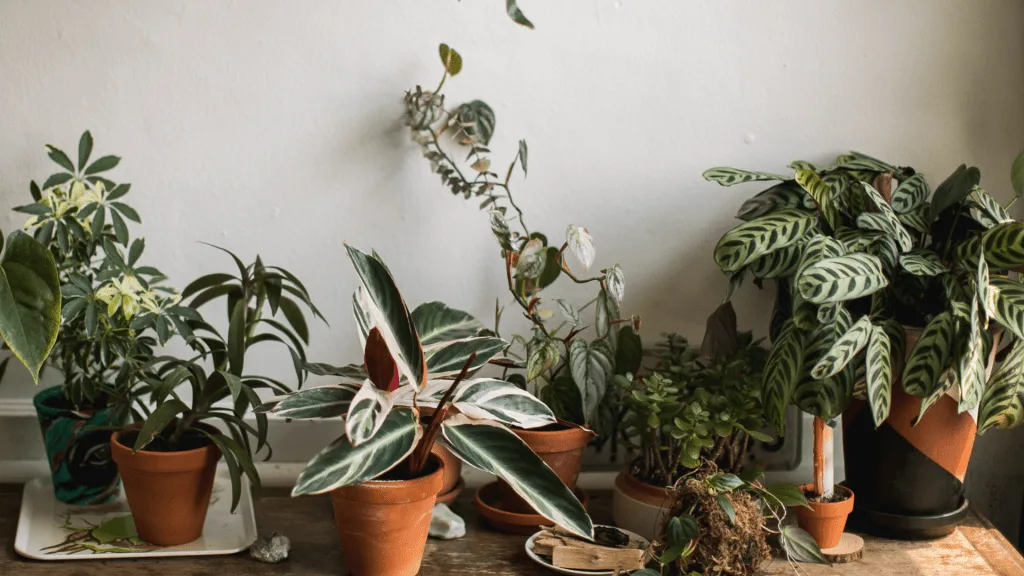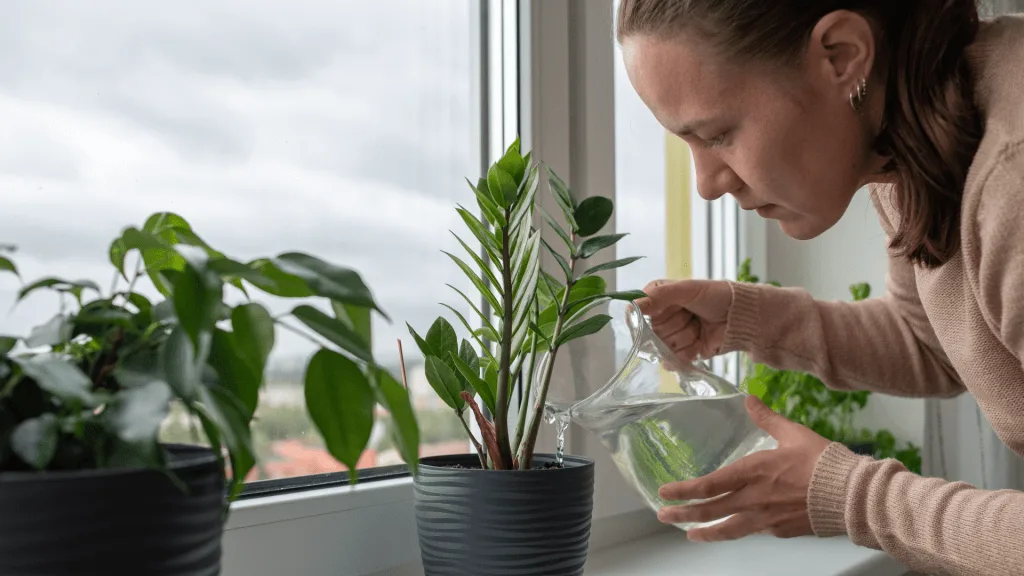No matter how green your thumb is, killing your houseplants is surprisingly easy. We would know because we’ve murdered monsteras, butchered bamboo, and even killed cacti.
So how can you ensure you don’t send your pretty green pets to garden heaven?
We have all the dirt on healthy plant parenthood, so you don’t make these common mistakes.
Let’s dig in!
Our Love Affair with Houseplants
The popularity of houseplants has exploded in recent years. People are obsessed with bringing the outdoors inside and filling their homes with lush greenery.
It’s no surprise this trend has taken off. Not only are indoor gardens aesthetically pleasing, but they’re also good for your health!
Scientific studies show that plants enhance cognitive function, reduce stress, and improve our overall well-being. Plus, they increase air quality by absorbing carbon dioxide and emitting oxygen.
Green thumbs will never get bored with their options. Countless species can thrive indoors if they’re in the right conditions. And new varietals are released all the time. Some people collect succulents, others are orchid lovers, and some folks just want a little of everything.
But it can be tricky to know what they need. They all have different requirements, and there’s no one-size-fits-all user manual. When our indoor gardens aren’t thriving, it’s easy to love them to death.
Here are some of the ways we destroy our little green friends.

Too Little or Too Much Water Will Kill Your Houseplant
Just like us, all plants need water to survive. But the correct amount is critical to their survival. Overwatering is the number one way we kill our greenery, and it often begins with the best intentions. After all, you don’t want them to shrivel up and die!
But too much wetness causes root rot, fungal growth, and, ultimately, a mushy death. This is especially true for species that don’t lose as much moisture to evaporation indoors. Further, the pots we put them in may not have adequate drainage.
On the flip side, dehydration can also be a death sentence. Plants with increased sun exposure are more prone to drying out. Once they lose too much moisture, there’s no going back.
The general rule of thumb is to let the top inch of soil dry out before watering again. Then, give the dirt a good soaking until moisture comes out of the bottom holes of your pot. Of course, this varies by species, but it’s a good starting point if you’re unsure.
Pro Tip: New to houseplant care? Avoid these 5 Ways to Accidentally Kill Your Monstera Plant.
Over-fertilizing Can Kill Your Houseplant
Outdoor leaves photosynthesize a lot, which means the soil requires more nutrients to keep them alive. If you’re used to gardening, you may assume your indoor greenery has the same requirements. But this is a surefire way to kill your houseplants.
Death by over-fertilization is usually a one-time event caused by improperly diluted nutrients. Additives are potent and can quickly burn roots. So always read the instructions before feeding your flora.
And if you never feed your houseplants, they’ll probably do fine anyway. All you have to do is repot them with fresh soil every year or two, and they’ll have everything they need.

Too Little or Too Much Sunlight Can Mean a Dead Houseplant
The right amount of light is also crucial for the health of your plants. Without enough, they can’t properly photosynthesize. Too much sun can bleach the leaves and dry out the soil. They can get sunburned, just like people.
Artificial light might keep them alive, but most need some natural sunlight to thrive. Depending on the species, they may require direct or indirect rays.
Whenever you purchase a new houseplant, take note of the variety and do a little research when you get home. Nursery staff is usually very knowledgeable about everything they have in stock and can be a great resource.
If you’re unsure of a specific species’ needs, placing it somewhere it can see the sky is a good starting point. They usually do well near a bright window that won’t receive too much direct sun.
Indoor Houseplants Are Susceptible to Pests
You might think that by keeping them indoors, you can avoid the creepy crawlies that live in your garden. But houseplants can harbor insects just like those outside.
Frequently, soil gnats lay their eggs in the dirt, only to emerge after you’ve brought a new addition home. Or a few sneaky mealybugs might hide on the underside of the leaves and evade detection until it’s too late. What makes it even worse is that an infestation can spread to your entire indoor garden.
If you find insects on your houseplants, you can try several methods to kill the offenders and avoid an infestation.
First, get the problem far away from your other pots. Taking it outside will expose it to beneficial insects that might feed on the pests. You can spray off the leaves with a garden hose, then use a mild soap or insecticidal oil to kill any stragglers. Be sure to read the instructions before treating!

Getting Pot Bound Can Kill Your Houseplant
When you buy a new houseplant, there’s no way to know how long it’s been sitting on the nursery shelf. And over time, roots grow too large for the container. If you pull it out of the pot and see a giant swirling mass in the soil, it’s time to move it up a size.
When they become potbound, the roots can’t absorb nutrients, water, or even oxygen (yes, leaves soak up carbon dioxide, but the roots take in oxygen!) That’s why ensuring they have room to grow is essential.
Letting your houseplants become rootbound is an easy way to kill them. After all, They may look ok on the outside, but their inability to absorb nutrients will become apparent over time. If you’re unsure what’s wrong, peeking under the dirt is a good idea.
Pro Tip: Spring has sprung. Try planting these 10 Most Beautiful Spring Flowers and How to Plant Them
Take Care of Your Plant Babies
We’re obsessed with our houseplants, but we’ve managed to kill a few ourselves. Because they all have different requirements, losing track of what each one needs is easy. Before we know it, we’ve loved them to death.
The takeaway is to know what you’re growing and what it requires. How much water, sunlight, and nutrients will vary by species. It might help to make a little notecard for each one or keep a list of your green babies in a notebook, so you can brush up on them when they start looking sad.
We’ll Help You Find the Best Free Camping in the USA
You should give it a try!
As a matter of fact, these free campsites are yours to enjoy. Every time you pay federal taxes, you’re contributing to these lands.
Become a FREE CAMPING INSIDER and join the 100,000 campers who love to score the best site!
We’ll send you the 50 Best Free Campsites in the USA (one per state). Access the list by submitting your email below: